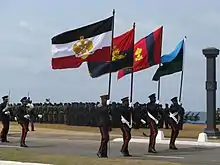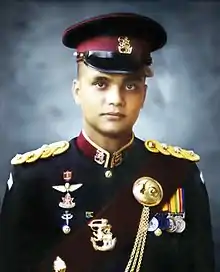Uniforms of the Sri Lanka Army
The uniforms of the Sri Lanka Army currently exist in several categories ranging from ceremonial uniforms to combat dress (with full dress uniform).[1]

General principles
Uniforms in the Sri Lanka Army originated from those of the British Army, which was instrumental in its formation and today share many similarities with the uniforms of the British and Commonwealth armies. Based on British Army traditions uniforms are differentiated according to the regiment (or corps) to which an officer or soldier belongs. There are several significant uniform differences between infantry and cavalry regiments; furthermore, several features of cavalry uniform were (and are) extended to those corps and regiments deemed for historical reasons to have 'mounted status' in the British Army.
Full dress is the oldest form of uniform and presents the most differentiation between units; although there is then a 'steady thinning out of regimental features', through ceremonial dress, service dress, barrack dress and combat dress, a level of regimental distinction runs throughout. Unlike in the British Army where senior officers, of full colonel rank and above, do not wear regimental uniform (except when serving in the honorary position of a Colonel of the Regiment) and use 'staff uniform'; senior officers of the Sri Lankan Army retain regimental features while incorporating elements of the British staff uniform (which includes a coloured cap band and matching gorget patches in several orders of dress) with a few local variations.
Full dress
Full dress is the most elaborate and traditional order worn by the British Army and such used by historical Sri Lankan regiments serving as part of the British Army, which include the Light Infantry and the Artillery. No longer in general used, such colorful uniforms are used for particular uses.
Scarlet full dress uniforms known as the No.1 Presidential Scarlet are used by the Sri Lanka Corps of Military Police mounting the President’s Ceremonial Guard. The gunners of the ceremonial gun troop of Sri Lanka Artillery wear (dark) blue full-dress uniforms when delivering a gun salute. The army and regimental bands wear colorful uniforms based on regimental colours and traditions.
Current
Ceremonial Blue/Green

The Ceremonial uniform (No. 1 Dress), sometimes referred to as "blues", is a universal ceremonial uniform which is almost consistent throughout the Sri Lankan Army. No. 1 Dress is only worn on ceremonial occasions, service weddings by only officers and the Regimental Sergeant Major. It is identical to the blue patrol uniform of the British Army and was formally designated as No. 2 Dress uniform. In the 1990s it formally made the No. 1 Dress uniform having been the de facto Dress uniform for many years. Therefore, some regiments still refer to it as No. 2 uniform. In rifle regiments the uniform is in dark green. Medals are worn and swords carried if ordered.
Service Dress uniform
The Service Dress uniform, is worn by senior officers for less formal occasions. It is based on the warm weather service dress uniform of the British Army. Medals are worn and swords carried if ordered. Traditionally known as the No. 4A it as now been adopted as the No. 2 and No. 3 by certain regiments.
Mess Dress
The mess dress uniform, includes a waist-length short jacket, with which men wear trousers, overalls or a kilt; and for women a long skirt. Known as No. 3 and No. 3A (without jacket), generally white jacket used by junior officers and warrant officers and a jacket of the regimental colour worn by senior officers frequently includes elaborate braiding on the waistcoats. Female NCOs would wear sarees of a designated design.
Camouflage uniform
Camofluge uniform also known as no. 7 dress. Camofluge pattern is changes regiment to regiment of the army. All ranks of the army can wear this uniform when attending field training and field exercises.
Obsolete
No. 1 Ceremonial White
The No. 1 Ceremonial White dress uniform, was the most formal uniform in Sri Lankan Army. No. 1 was a full white uniform while No. 1A was a white tunic and dark blue trousers similar to the British Army Warm weather ceremonial uniform. No. 1 was reserved to be used by Army officers appointed and serving as Aide-de-camp (ADC) to the President of Sri Lanka at ceremonies. A tradition that dates back to the time when army officers were appointed as Aide-de-camp to the Governor of Ceylon during day time. While No. 1 A uniform was used for day time functions. The uniform as since been discontinued and army officers assigned as ADC to the President wear the ceremonial blue uniform for all formal functions while the Service Dress uniform is used by other officers for day time functions.
Khaki drill uniform

British Army style Khaki drill uniforms were used by the Ceylon Army from its formation into the 1970s. Khaki has since been replaced with olive green, with the exception of peaked caps that remain khaki in most regiments. These included shorts.